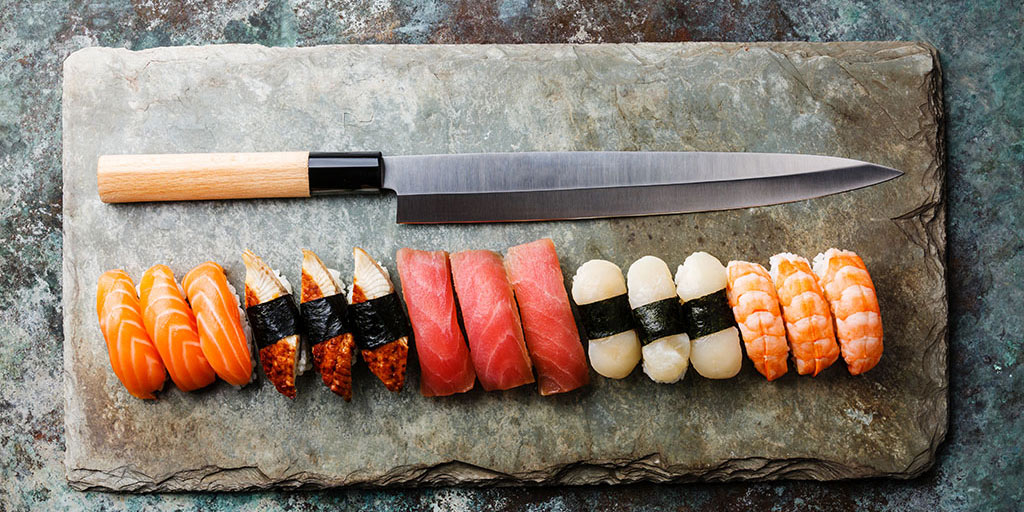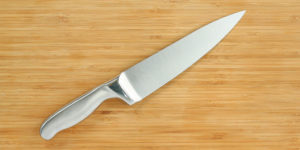The Best Japanese Kitchen Knives
For centuries, Japan has been at the center of making some of the finest blades in the world. They have strength, hardness, and are legendary for retaining their cutting edge. So, it comes as no surprise that some of the best kitchen knives come from Japan.
We look at four Japanese knives to determine their pros and cons, and crown the Dalstrong Santoku 7-inch Shogun Series as our HowToHome pick for durability, sharpness, balance, and the strength of the blade.
- 67 layers
- High-carbon stainless steel
- G-10 military-grade handle
- Rockwell hardness of 62+
- Scalpel-like edge
- Lifetime warranty
- 45 layers
- High-carbon stainless steel
- G-10 handle
- Rockwell hardness of 61
- Lifetime warranty
- 46 layers
- High-carbon stainless steel
- Magnolia wood handle
- Rockwell hardness of 60
- Lifetime warranty
- High-carbon stainless steel blade
- Wooden handle
- Rockwell hardness of 56-58
- Lifetime warranty

Dalstrong is an industry leader in kitchen knives, and their Japanese range is highly regarded around the world. This Santoku knife (Japanese for “three virtues” or “three uses”) is no exception.
It has almost anything you could want in a quality Japanese knife; full tang for better control and balance, meaning the entire knife is constructed from one piece of metal, with the two sides of the handle grip bolted to it. This is the strongest of all the tang types.
Also, the handle is a military-grade G-10 type, which is crafted from a fiberglass composite that is applied in layers to create a tactile, high-grip surface.
This Dalstrong scores highest on the industry standard Rockwell Hardness Scale, at 62, which is an excellent measure of the resilience of the blade. The fine cutting edge is created using the ancient hand-finished 3-step Honbazuke method, which our buyer’s guide explains in more detail.
This knife also has the most layers, at 67, meaning that the blade is super-strong. And because it’s nitrogen-cooled during the manufacturing process, it adds to the durability of the steel, protecting the cutting edge.
On the downside, because of the sophisticated way this knife is sharpened, when it finally dulls you are going to have to learn the complexities of sharpening techniques to continue to protect the blade. It is possible to use a knife sharpener, but it you value your cutting edge, the traditional methods are still the best.
That said, investing in this premium knife is worth it because it gives you the best balance, strength, sharpness, and control. That’s why we made it our HowToHome pick.
Pros
- Strength
- Super-sharp
- Double-edged blade
- 67 layers
- Ergonomic military-grade handle
Cons
- Needs complex sharpening
Zelite Infinity is the other dominant name in the Japanese knife industry, giving Dalstrong a run for their money.
This 8-inch chef’s knife is an excellent example of what they can produce, not least because it is elegant and would look good in any kitchen, but because it is a chef’s knife, it is the most versatile of all the choices in the review. It can handle almost every task in the kitchen, and that’s why we chose this as our versatile pick.
It has a full tang, and G-10 handle, just like the Dalstrong Santoku 7-inch Shogun Series. And when it comes to the Rockwell Hardness Scale, it scores an impressive 61, which is just short of the 62+ scored by the Dalstrong.
Zelite also uses the ancient Honbazuke sharpening method to achieve the best results. Plus, the blade is nitrogen cooled to protect the cutting edge.
But where the Dalstrong has the upper hand is in the number of layers the steel blade has. This Zelite Infinity has 45 layers, so is still a quality tool, but if you compare that to the HowToHome pick, with 67, you can see that the Dalstrong just edges it in a couple of crucial categories.
On the downside, the blade is broader and the handle longer than most similar knives in its class, meaning that it’s more cumbersome to use. If used for long periods, it could put added strain on your hands and wrists.
Overall though, this Zelite is stylish, performs well, and holds its sharpness, so although we chose this as our style pick, it proves that this knife is more than good looks.
Pros
- Great styling
- Honbazuke sharpened
- Nitrogen cooled
- Hardness score of 61
Cons
- Heavier than other knives in its class
Yoshiro makes knives the old fashioned way by handcrafting each one to keep the traditions of Japanese knife making alive. This Gyuto knife, or “beef knife” if you use the literal translation is the equivalent of a European French chef’s knife.
It has a full tang, like the Dalstrong and the Zelite, but it also has a traditional hexagonal magnolia handle, rather than the military-grade G-10 variety. The Rockwell hardness score is impressive at 60, but still short of the HowToHome pick. And the Damascus steel blade is hand-hammered to create all those dimples, for less friction when cutting ingredients.
Because the blade is made in the traditional way, modern innovations like nitrogen cooling are not employed; however, the 46 layers of high-carbon steel does beat the Zelite Infinity by one layer.
On the downside, because Yoshiro makes each knife individually by hand, expect to pay artisan prices. As beautiful and tactile as this knife is, it is by far the most expensive in the review.
That said, if we are making a case for Japanese knives, then we would be remiss if we left out the traditional handcrafted option, especially when you consider the skills needed to craft such a knife.
Pros
- Handcrafted
- Totally individual
- Traditional Magnolia handle
- Hardness core of 60
Cons
- Very expensive
- No nitrogen cooling to protect the blade edge

When you consider that to purchase a premium-grade kitchen knife, you would expect to spend $100 or more, which makes this Augymer chef’s knife all the more remarkable given the price. It retails at almost 1/10th of the Yoshiro Gyuto Japanese Chef’s Knife.
So, because of the price tag, this knife will be lacking some of the crucial things that distinguish a quality Japanese knife from a budget option. This knife has no full tang, so don’t expect the same balance and control as the other three featured. Also, it isn’t constructed from layered steel, but instead uses a single piece of high-carbon stainless steel, so it shouldn’t rust, but lacks the strength that layered steel brings.
The patternation on the blade is lasered on to give the appearance of Damascus steel, but it’s only there for decoration, and the wooden handle is ergonomic to make the cutting experience more comfortable.
The Rockwell Hardness score is a respectable 56-58. When you compare it to the more expensive models in the review and consider that it is by far the cheapest model featured; it is worth noting that it still has an extremely high approval rating on Amazon for such an inexpensive item.
Pros
- Great price
- High-carbon stainless steel
- 56-58 hardness score
- Ergonomic wooden handle
Cons
- Damascus pattern is lasered on
- The blade dulls easily
- Build quality issues
- No layers
Comparison Chart
| Dalstrong Santoku 7-inch Shogun Series | Zelite Infinity 8-Inch Chef’s Knife | Yoshiro Gyuto Japanese Chef’s Knife | Augymer 8-Inch Chef’s Knife | |
| Type of knife | Santoku | Gyuto | Gyuto | Gyuto |
| Rockwell score | 62+ | 61 | 60 | 56-58 |
| Full tang | ✓ | ✓ | ✓ | X |
| High-carbon | ✓ | ✓ | ✓ | ✓ |
| Damascus steel | ✓ | ✓ | ✓ | X |
| Nitrogen cooled | ✓ | ✓ | X | X |
| Honbazuke sharpened | ✓ | ✓ | X | X |
| Layers | 67 | 45 | 46 | X |
| Weight | 8.5 oz | 10.1 oz | 4.8 oz | 6.9 oz |
| Dimensions | 12.2 x 1.8 x 0.1 | 13.5 x 0.9 x 2.3 | 14 x 0.1 x 1.8 | 13 x 2.6 x 1.2 |
| Corrosion resistance | ✓ | ✓ | ✓ | ✓ |
| Handle material | G-10 | G-10 | Wooden | Wooden |
| Warranty | Lifetime | Lifetime | Lifetime | Lifetime |
| Price | $$ | $$ | $$$ | $ |
Buyer’s Guide:
Japanese Knife
Final Thoughts
Owning a Japanese knife brings advantages and makes life in the kitchen that much easier, so if you want to invest in a quality Japanese knife, look no further than the Dalstrong Santoku 7-inch Shogun Series. It is durable, beautiful to use and to look at, has 67 layers, and above all scores the highest on the hardness scale. This had to be our HowToHome pick!
For a budget option, the Augymer 8-Inch Chef’s Knife is an excellent pick, because it is a fraction of the price, yet delivers a level of performance far above the price tag.
If you are looking for a traditional handcrafted Japanese knife, then the Yoshiro Gyuto Japanese Chef’s Knife will be the one for you. It is made using old techniques passed down from master to master, and each knife is unique.
For those who want an all-round performer, capable of almost any task, the Zelite Infinity 8-Inch Chef’s Knife delivers a level of performance and reliability and looks great in the bargain. This Zelite is only second to the Dalstrong by a whisker, and it means you are not compromising on the quality when you buy this knife.
We get that the choices seem endless when shopping for a Japanese knife, but hopefully, we have made that search a little easier.







